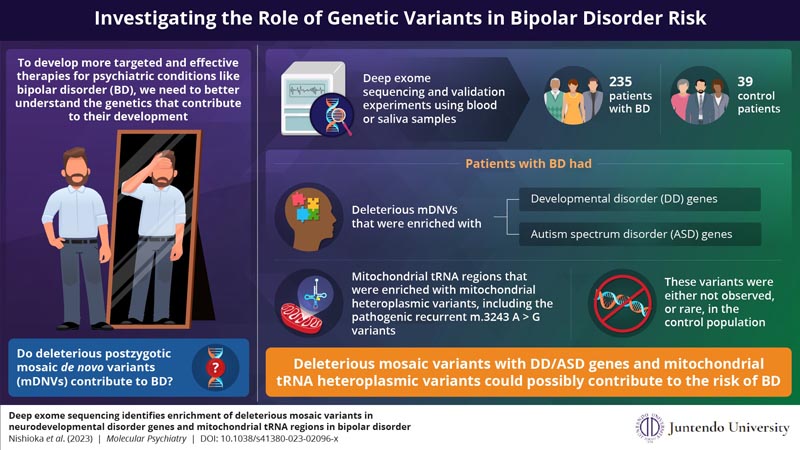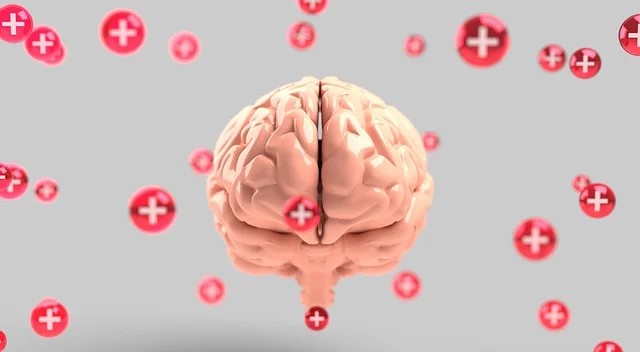Researchers find link between bipolar disease and potentially pathogenic mosaic mutations found in genes for neurodevelopmental disorders and mitochondrial tRNA genes
Deep exome sequencing identifies enrichment of deleterious mosaic variants in neurodevelopmental disorder genes and mitochondrial tRNA regions in bipolar disorder Summary Bipolar disorder ( BD) is a global medical problem that affects around 1% of the population with manic and depressive episodes . Despite several genetic studies, the genetic architecture and pathogenesis of TB have not been completely resolved. In addition to germline variants, postzygotic mosaic variants are proposed as new candidate mechanisms contributing to TB. Here, we performed extensive deep exome sequencing (DES, ~300×) and validation experiments to investigate the roles of mosaic variants in BD with 235 BD cases (194 trio probands and 41 singleton cases) and 39 controls. . We found enrichment of developmental disorders (DD) genes in genes affected by deleterious mosaic variants in BD (P = 0.000552), including a pathogenic variant recorded in ClinVar in ARID2. An enrichment of deleterious mosaic variants was also observed for autism spectrum disorder (ASD) genes (P = 0.000428). Proteins encoded by DD/ASD genes with nonsynonymous mosaic variants in BD form more protein-protein interactions than expected, suggesting molecular mechanisms shared with DD/ASD but restricted to a subset of cells in BD. We also found a significant enrichment of mitochondrial heteroplasmic variants, another class of mosaic variants, in mitochondrial tRNA genes in BD (P = 0.0102). Among them, recurrent m.3243 A > G variants known to cause mitochondrial diseases were found in two unrelated BD probands with allele fractions of 5–12%, lower than in mitochondrial diseases. Despite the limitation of using peripheral tissues, our DES research supports the possible contribution of deleterious mosaic variants in the nuclear genome responsible for more severe phenotypes, such as DD/ASD, to TB risk and further demonstrates that the same paradigm is can apply to the mitochondrial genome. These results, as well as the enrichment of heteroplasmic mitochondrial tRNA variants in TB, add a new piece to the understanding of the genetic architecture of TB and provide general information on the pathological roles of mosaic variants in human diseases. |

Comments
Mosaic mutations in neurodevelopmental disorder genes and mitochondrial tRNA genes have been found to be involved in the pathophysiology of bipolar disorder.
Image : Japanese researchers showed that genes associated with developmental disorders and autism spectrum disorders are significantly enriched with deleterious mosaic mutations in patients with bipolar disorder (BD). Similarly, the mitochondrial tRNA region of these patients also showed significant enrichment for deleterious mosaic mutations. These findings help to better understand the genetics and pathogenesis of TB . Credit: Masaki Nishioka of Juntendo University
Bipolar disorder ( BD) is a major psychiatric condition that affects approximately 1% of people. Symptoms of BD include the sudden onset of a depressed mood with loss of interest alternating with a manic state of hyperactivity. The suffering of patients and the social cost of this disorder requires the use of continuous therapeutic management. Current medications, although vital for TB patients, are not perfect solutions, given their potential side effects and resistance to treatment. This requires the development of better therapies for TB, including precision medicine. However, a major obstacle to this process lies in our limited understanding of the underlying biological mechanisms of TB, that is, its pathogenesis and the genetic architecture of people with TB. Several studies have linked BD to inherited mutations, but recent genomic studies are now focusing on somatic mosaic variants (new mutations that occur during developmental stages) as another possible mechanism behind psychiatric disorders such as BD.
In a new study published in Molecular Psychiatry , a team of researchers led by Associate Professor Masaki Nishioka of Juntendo University, Japan, investigated the association between mosaic variants and TB risk. The research team included Dr. Tadafumi Kato, also from Juntendo University, and Dr. Atsushi Takata from the RIKEN Center for Brain Science. "Most analyzes exploring the genetic mechanisms of TB involve extracting information from mutations that are shared among all patients’ cells. However, de novo mosaic mutations or somatic mutations, which arise during development, do not are shared among all cells. We know very little about how these mutations influence diseases like TB. Therefore, for our study, we hypothesized that mosaic deleterious de novo variants (mDNV) in genes associated with brain disorders development may play a role in TB pathology," explains Dr. Nishioka.
The team recruited 235 participants with BD and 39 control participants without psychiatric disorders. They collected blood or saliva samples from participants and analyzed DNA extracted from these samples using deep exome sequencing (DES) to detect mosaic variants that originated during early development. Participants with TB had mosaic variants enriched in genes that are responsible for causing developmental disorders (DD) and autism spectrum disorders (ASD). Furthermore, the proteins encoded by the DD/ASD genes with the proteins of the mosaic variants were closely linked and had more protein-protein interactions than expected.
Surprisingly, the team also found significant heteroplasmic mutations (another class of mosaic variants) in mitochondrial tRNA genes from participants with TB. For reference, some tRNA mutations are known to be pathogenic for other diseases. In fact, two participants with mitochondrial tRNA mutations had recurrent m.3243 A > G variants, which are known to be the main causal variants of mitochondrial diseases, MELAS, which is a serious neurodevelopmental disorder. This finding complements other studies that have found that patients with mitochondrial diseases often present with symptoms of bipolar disorder or schizophrenia.
Furthermore, both sets of deleterious mosaic variants (mDNV and mitochondrial tRNA variants) were absent or rarely observed in control participants. These results indicate that the molecular mechanisms underlying DD/ASD could also contribute to TB in a compromised manner through mosaic mutations. Furthermore, they suggest that mitochondrial tRNA variants could be associated with TB even though the patient does not show obvious symptoms of mitochondrial diseases.
With this study, the researchers demonstrate that mosaic mutations, particularly those in genes for neurodevelopmental disorders and mitochondrial tRNA genes, may be involved in the pathophysiology of BD. Dr. Nishioka is encouraged by what the findings from his study mean for scientists pursuing molecular pathology research in neuropsychiatric diseases. He concludes: "Our research sheds new light on the genetic architecture of TB and provides more information on the pathological contribution of mosaic variants in human diseases. This could potentially pave the way and accelerate new research for the development of more effective precision medicines for the treatment of TB and other psychiatric disorders.
















